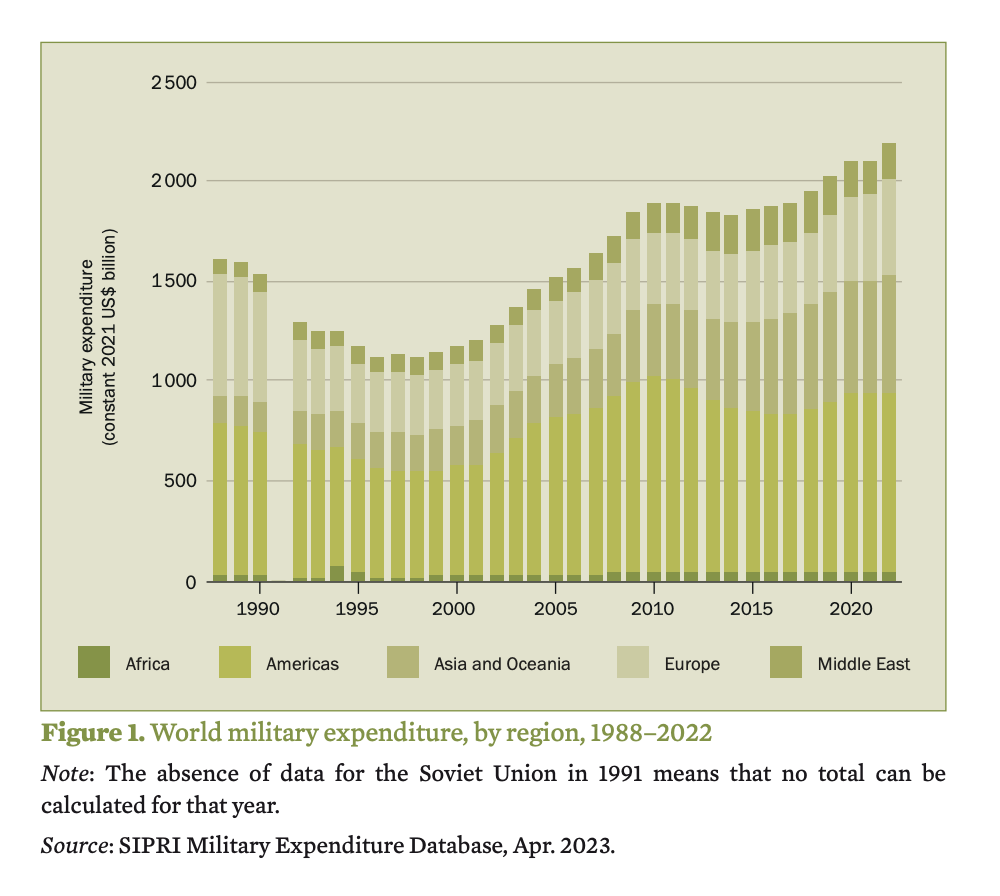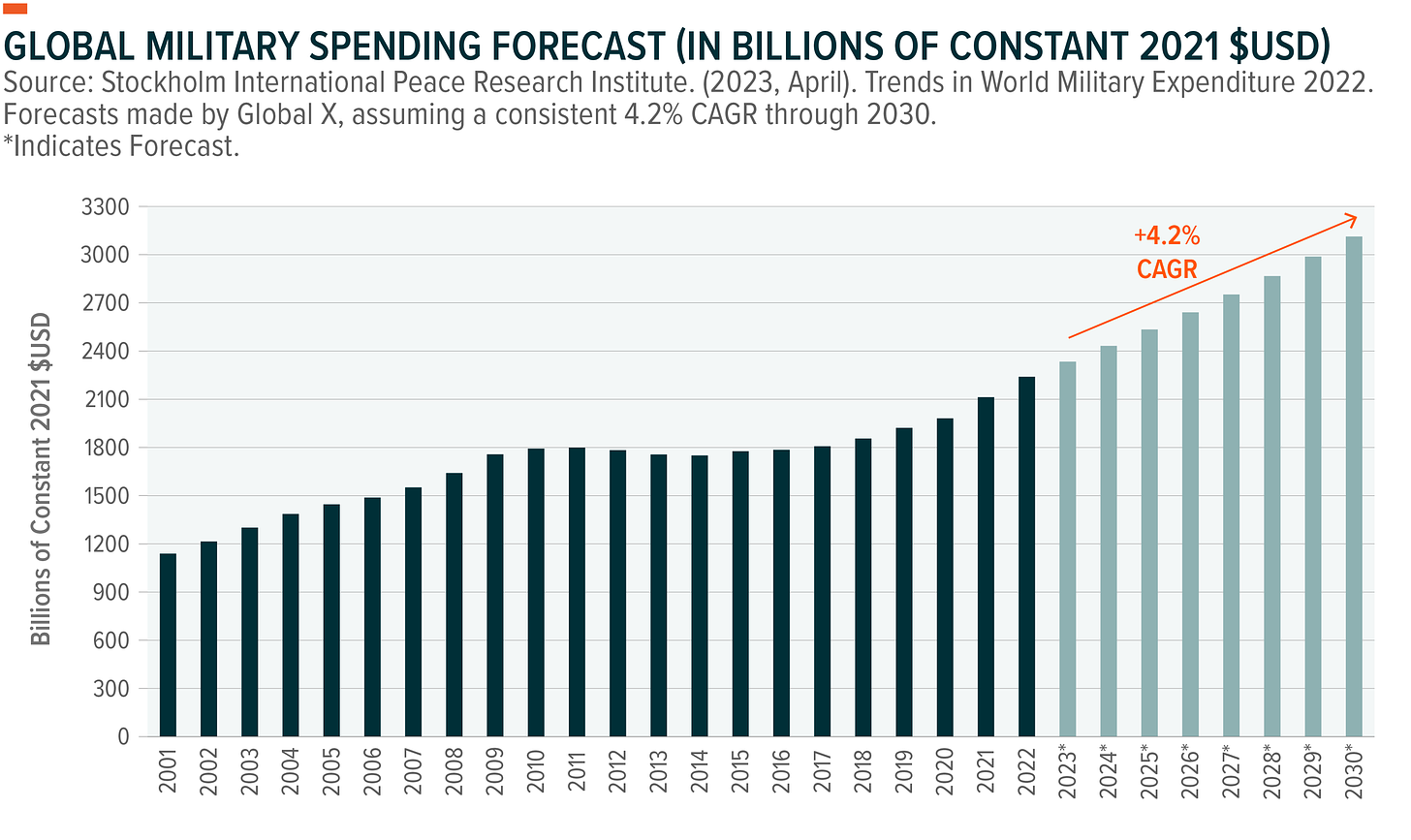In the “first” Cold War, Russia and China were the No. 1 U.S. threats.
It was true then. And it’s true again … as the New Cold War spools up.
Just look at how former Deputy U.S. National Security Advisor Elliott Abrams introduced his National Review essay, “The New Cold War,” when he shared it with the U.S. Council on Foreign Relations, where he’s a senior fellow:
“It is now a commonplace [view] that a new Cold War has begun, brought upon the West by the aggressive partnership of Xi Jinping and Vladimir Putin,” said Abrams, when he introduced that March 2022 report. “But it has been 30 years since the Cold War ended, and many Americans (and Europeans) are too young to know or have forgotten what the Cold War was like – and how the United States led the free world to victory. The combination of military strength and ideological pressure that led to victory will be needed again.”
Warns Abrams: “We are not ready — militarily, politically, or psychologically — for the prolonged crisis ahead of us.”
That opportunity for “prolonged crisis” is front and center … if you just take a moment to look.
Military spending is marching higher across the globe. New enemies are emerging – as old ones return. Breakthroughs in sensors, drones, artificial intelligence (AI), potential space weapons and hypersonic missiles have spawned new weapons systems – neutralizing the defenses that have “protected” us for decades.
A “new isolationism” is unfolding. Academics want to call it “regionalization.”
But deglobalization is a more-accurate term.
We’ve got trade sanctions against Russia. A deepening schism with China. Growing flintiness in the Arctic. A stepped-up nuke program in North Korea. Dangerous military regimes in the Sahel Region of Africa. And with the West backing Ukraine’s defense against Russia, proxy wars have returned.
The bottom line: We’re looking at a “deteriorating security environment,” says a new report issued in mid-February by the International Institute for Strategic Studies (ISS). With the military spending surge, we’re facing “what is likely to be a more-dangerous decade” to come, the ISS says.
Once more unto the breach, my friends. But … fear not … there will be plenty of ways to protect yourself and your money. And new technologies create real investment opportunities.
In Part I of this two-part Stock Picker’s Corner (SPC) report on the “New Cold War,” I gave you folks a personal tour of that “first” Cold War – as a “table-setter” for what’s to come.
Here in Part II, we show you exactly what’s happening, and outline those opportunities.
And numbers are a good place to start.
A Decade of Growing Budgets
Take a look at the chart below and you can see how worldwide military outlays seemed to plateau between 2009 and 2016. But that spending has accelerated strongly in the last few years – thanks to the perceived threat from China, a more-militant Russia, a nuclear-aspiring North Korea and new threats from harder-to-bullseye “stateless” enemies.
Global military spending jumped 3.7% in 2022 to hit a record $2.24 trillion, says the Stockholm International Peace Research Institute (SIPRI), an independent think tank that’s one of the leading experts on arms, military spending and other global security issues. And it will continue to grow — approaching $3.3 trillion by decade’s end, SIPRI says.
The three largest spenders — the United States, China and Russia — accounted for 56% of that $2.24 trillion total. And the 13% jump in spending in Europe was the steepest year-over-year surge in 30 years.
The United States is far and away the world’s No. 1 military spender. U.S. outlays hit $877 billion in 2022 – 39% of total global military spending and three times the $292 billion spent by China, the No. 2 player in military budgets.
Military spending has helped rev China up into a true superpower. That $292 billion for 2022 was 4.2% more than in 2021. And it was 63% more than in 2013, SIPRI says.
Beijing has boosted China’s military budget for 28 years in a row.
“The continuous rise in global military expenditure in recent years is a sign that we are living in an increasingly insecure world,” Prof. Nan Tian, senior researcher with SIPRI’S Military Expenditure and Arms Production Programme, said of the numbers. “States are bolstering military strength in response to a deteriorating security environment, which they do not foresee improving in the near future.”
The Russia/Ukraine War has hugely influenced these numbers, though many of the one-time Eastern Bloc countries have more than doubled their military budgets since 2014 – the year Russia annexed The Crimea.
Russian military spending grew by an estimated 9.2% in 2022, to around $86.4 billion. That’s equal to 4.1% of Russia’s gross domestic product (GDP) in 2022, up from 3.7% of GDP in 2021.
Figures released by Russia in late 2022 show that national defense spending – the single-biggest slice of that country’s military outlays – was already 34% higher (in nominal terms) than what had been budgeted the year before.
“The difference between Russia’s budgetary plans and its actual military spending in 2022 suggests the invasion of Ukraine has cost Russia far more than it anticipated,” said Prof. Lucie Béraud-Sudreau, Director of SIPRI’s Military Expenditure and Arms Production Programme.
Call it “Newton’s Third Law of the New Cold War,” but for every action there’s going to be a major reaction.
Like with Japan.
With “neighbors” Russia and China each dropping more on their armies, navies, air forces and weapons systems — and also collaborating more closely — Japan is changing its spots. We’re talking about a country whose land, air and sea forces were, by law, defensive in nature (Article 9 of its constitution prohibits Japan from establishing a military).
But a new security mindset took hold in 2022 – one that will boost that island nation’s military spending in a big way going forward. Those outlays jumped a hefty 5.9% that year, reaching $46 billion, or 1.1% or GDP – the highest spending level since 1960. There’s a growing public debate about scaling back Article 9 — or eliminating it completely.
Because of perceived threats — mostly from Chinese or Russian military aircraft — Japanese jets had to “scramble” (take flight) 778 times in fiscal 2022. And that’s after 1,004 scrambles the year prior. Japan’s aerial Self Defense Force has had to scramble jets more than 700 times annually since 2013.
And just this month, Japan’s top spokesman said his country is “gravely concerned” about the way Beijing and Moscow are working together, tightening collaboration between China and Russia, telling reporters that “our government intends to keep a close eye on development(s) in Sino-Russian Relations.”
And like the United States, Japan is also worried about North Korea, which has been testing nuclear weapons as well as ballistic missiles for years. (Leader Kim Jong Un is expected to again ramp up testing ahead of the November presidential election.)
Big Trends, Big Opportunities
Our mantra here at SPC is “follow the storylines and you’ll find the wealth-building opportunities.” We believe that because if you follow the storylines, you see where the money is flowing.
Along with Biotech Blockbusters, Artificial Intelligence (AI) and a few others, the New Cold War is one of our core storylines right now.
And it really is influencing where the money is flowing.
If you follow that New Cold War money, you’ll see the power shifts taking place.
You’ll see the threats you need to find protection against.
You’ll find the innovations.
You’ll find the beneficiaries.
And you’ll find the “Wealth Builder” moves.
In the last few weeks alone, some key New Cold War players have unveiled new defense budgets.
China said it’s boosting defense spending by 7.2% to $230 billion in 2024. That’ll follow increases of 7.2% in 2023, 7.1% in 2022, 6.8% in 2021, 6.6% in 2020 and 7.5% in 2019, government reports say. (And some experts claim Beijing understates those figures.)
The Biden Administration defense request for 2025 rose only 1% (less than the 3.2% inflation rate), as part of an escalating budget scrap on Capitol Hill. But, long term, Washington will need to find ways to keep pace with the growing spending of its enemies.
According to Statista, which uses a slightly narrower definition of defense outlays, U.S. defense spending is projected to increase every year until 2033, growing from $746 billion in 2022 to $1.1 trillion in 2033. That $1.1 trillion roughly equals the current economy of Saudi Arabia and would represent an aggregate gain of 47.5%.
Look, we all know that projecting anything a decade into the future – and expecting those projections to be spot-on accurate – is a fool’s errand. But the trend is useful, and the magnitude can be reliable.
And we’re already seeing the impact.
In fact, here’s a short “checklist” of some (but not all) of the changes and opportunities being triggered by the New Cold War:
Degloblalization: I’ve been a reporter/observer/stock picker long enough to remember when a true “global economy” was taking shape. U.S. President Richard Nixon (who I later interviewed as a reporter) opened trade relations with China way back in 1972. Following the fall of the Berlin Wall, some of you may remember “Europe 1992,” the push to unify Europe as a single market with a single currency. Over time, Asia became the “factory to the world,” which led the United States to “offshore” its industrial might. The New Cold War is helping reverse those decades of globalizing efforts – and is shifting us back into trading blocs. Here in America, that’s led to “onshoring” – bringing production back to the Mainland USA. One clear example is with semiconductors, which are the “brains” of just about every sophisticated product you can think of. There are 73 new semiconductor “fabs” (production facilities) being built worldwide right now, including 35 in the West, says Z2 Insights. Of those 35, 27 (77%) are being built here in the United States. That alone will create lots of new business for companies like chip-equipment maker Applied Materials Inc. AMAT 0.00%↑ and chip giant Intel Corp. INTC 0.00%↑, which wants to do contract-production work in its fledgling Intel Foundry Services unit.
Drones, Drones and More Drones: At the annual NATO Munich Security Conference, held in mid-February, officials listed drones and AI as the two of the biggest current threats to global security – because those technologies can circumvent existing conventional defenses. Shouldn’t surprise you. If you’ve been watching the headlines, the “D Word” (drones) is present almost daily. And we’re not talking about consumer “quadcopters” being used for photography, or commercial drones that can deliver products, survey land or map historic sites. We’re talking about weapons systems whose smallness, radar-evading agility and “smart” weapons arsenals make them super effective – especially with higher-risk missions, since there are no human crews to worry about. An unmanned aerial vehicle (UAV) killed U.S. troops in Jordan in January. The Ukraine has been using aerial drones to take out Russian missile sites, parked aircraft and oil refineries. And it has used seagoing drones to knock out Russian warships. Hamas used drones in its October attack, sending them in first to “blind” Israeli defenses by hitting watchtowers and security cameras. And unmanned surface and undersea (UUV) drones are attacking shipping in the Red Sea. The U.S. military is developing jet drones that can serve as unmanned “loyal wingmen” for American combat planes. And The Boeing Co. BA 0.00%↑ has developed drone subs and even tested an unmanned aerial tanker that can refuel jets flying long combat missions in the growing-hotter South China Sea.
New Defense Systems: Conventional missiles, antiaircraft guns and manned interceptors are a costly and less-than-effective way to find and shoot down drones. One candidate is a “directed-energy weapon” (DEW) that uses high-powered microwaves to cook a drone’s electronics. Another version of this so-called “drone zapper” technology has been tested in real conditions – shooting down an enemy drone while aboard a U.S. ship in the Strait of Hormuz. Experiments with lasers and other technologies have been used, too. A key element of any defense system will be sensors and radar. And one of the biggest beneficiaries might be RTX Corp. RTX 0.00%↑ , formerly Raytheon.
Hypersonic Weapons: We’re talking here about a weapon that can travel at “hypersonic” speeds – anywhere between five or 25 times the speed of sound (or one to five miles per second). One version, a hypersonic glide vehicle (HGV), uses a missile to “boost” the warhead to maximum altitude, after which it’s ejected and then glides back through the atmosphere – perhaps maneuvering in a way that blunts such traditionally effective air defenses like the Patriot missile interceptor. The United States had the lead in this next-generation technology, but has since been leapfrogged by China and Russia. China is infamous for its DF-21 anti-ship missile – known as the “carrier killer” for its intended role in knocking out U.S. aircraft carriers during any skirmish involving the South China Sea. It’s since developed newer versions. In May 2023, China said it used hypersonic missiles to “blow up” the world’s biggest carrier, the USS Gerald R. Ford, during a war simulation – claiming this proved the U.S. ship could be “destroyed with certainty.” Russia has deployed its new Mach 10 Kinzhal (Dagger) hypersonic missile against the Ukraine. Ukrainian forces last year used an “old fashioned” Patriot interceptor to down a supposedly “invincible” Kinzhal, with contractor Lockheed Martin Corp. LMT 0.00%↑ saying that the U.S. missile system had undergone a software upgrade to better handle a more-advanced threat. New weapons systems – especially missile interceptors like the super-advanced U.S. Terminal High Altitude Area Defense (THAAD) system and new DEW systems will need to be developed to counter the very real hypersonic threat. Lockheed and RTX are both THAAD contractors. And they are developing an expertise in next-gen missile defenses. A common element to most of these systems is advance warning – which means sensors and radar. And one of the best radar systems in the world is the X-Band active electronically scanned array radar system made by Raytheon.
Cyberwarfare and AI: Cyber weapons have created a new “theater of war” – a digital one. Take Russia. Although its physical war against The Ukraine commenced in February 2022, Moscow’s cyberattacks against that country have been waged since Russia illegally annexed the Crimea in 2014, a European Parliament briefing paper says. China has an active and aggressive “Internet Army.” So does North Korea. The United States allegedly launched a cyberattack against a suspected Iranian spy ship in February 2024. And the U.S. and Israeli security forces collaborated to create the first known cyberweapon – the so-called Stuxnet computer worm – which was deployed more than a decade ago in an attempt to slow Iran’s nuclear program. AI will elevate the digital battlefield threat. That’s why the conferees at the afore-mentioned NATO Munich session focused so heavily on AI. That digital battlefield can be used to launch “unconventional” attacks – like using deepfake technology to influence another country’s election – a worrisome premise given that a U.S. presidential election looms – and will unquestionably be one of the flintiest in U.S. history. Indeed, the discussions about AI in cyberspace and on social media drew huge conference crowds. And Adobe Inc. ADBE 0.00%↑ General Counsel Dana Rao told listeners that “once you’ve been fooled by a deepfake, you’re no longer going to believe anything you see and hear online. Once you doubt everything you see, that’s a danger to democracy.” Two plays to consider here are the First Trust NASDAQ Cybersecurity ETF CIBR 0.00%↑ and the Global X Artificial Intelligence & Technology ETF AIQ 0.00%↑.
There you have it.
A two-part dossier on the New Cold War.
By knowing what to expect, you’ll be able to stay the course and protect yourself.
And you’ve got at least half a dozen investment opportunities to consider.
See you next time…









